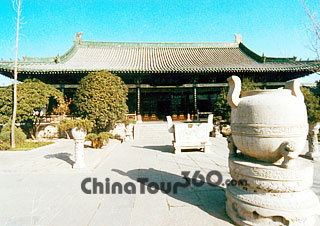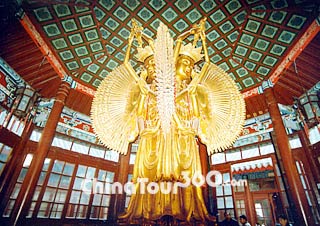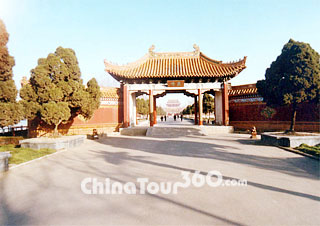 Lord Bao Temple
Lord Bao Temple Xiangguo Temple
Xiangguo Temple The Dragon Pavilion
The Dragon Pavilion
![]() Facts
Facts
Phone Code: 0378
Postal Code: 475000
Area: 6,444 square kilometers (2,488 square miles)
Population: 5.35 million
Nationalities: Han, Hui, Manchu, Mongolian, Zhuang, Chaoxian
Location: Kaifeng, in the east of Henan Province, is one of the most famous tourist cities along the Yellow River in Central China. It neighbors the Shangqiu City in the east, Zhengzhou in the west, and Xuchang and Choukou in the south. In the north, Kaifeng faces Xinxiang across the Yellow River. Its longitude is between 113°52′15" E and 115°15′42" E, and latitude between 34°11′45" N and 35°01′20" N.
![]() Physical Features: Kaifeng lies on the middle and lower reaches plain of the Yellow River, and nearly 70% of its land is used for farming. The Yellow River System and Huai River System flow through the city.
Physical Features: Kaifeng lies on the middle and lower reaches plain of the Yellow River, and nearly 70% of its land is used for farming. The Yellow River System and Huai River System flow through the city.
![]() History: Kaifeng has a long history. Human habitation here dates back to the Neolithic Period. Kaifeng was an ancient capital for seven dynasties: the Wei Kingdom during the Warring States Period (476BC - 221BC), the Later Liang (907 - 923), Later Jin (936 - 946), Later Han (947 - 951) and Later Zhou (951 - 960) of the Five Dynasties Periods (907 - 960), the Northern Song (960 - 1127) and Jin (1115 - 1234) Dynasties. Kaifeng developed into the political, economic and cultural center of China, as well as one of the busiest cities in the world during the Northern Song Dynasty. The famous Chinese painting Along the River During the Qingming Festival portrays the prosperous scene of that period. Since the Yuan Dynasty (1271 - 1368) Kaifeng had been the capital of Henan Province. Not until the capital was moved to Zhengzhou in 1954 did Kaifeng become a municipality directly under the control of Henan provincial government.
History: Kaifeng has a long history. Human habitation here dates back to the Neolithic Period. Kaifeng was an ancient capital for seven dynasties: the Wei Kingdom during the Warring States Period (476BC - 221BC), the Later Liang (907 - 923), Later Jin (936 - 946), Later Han (947 - 951) and Later Zhou (951 - 960) of the Five Dynasties Periods (907 - 960), the Northern Song (960 - 1127) and Jin (1115 - 1234) Dynasties. Kaifeng developed into the political, economic and cultural center of China, as well as one of the busiest cities in the world during the Northern Song Dynasty. The famous Chinese painting Along the River During the Qingming Festival portrays the prosperous scene of that period. Since the Yuan Dynasty (1271 - 1368) Kaifeng had been the capital of Henan Province. Not until the capital was moved to Zhengzhou in 1954 did Kaifeng become a municipality directly under the control of Henan provincial government.
![]() Attractions: Thousand years of history has endowed Kaifeng with a profound cultural foundation. According to historical records and archeological discoveries, 6 cities were buried 3 – 12 meters (9.8 – 39.4 feet) under the ground of current Kaifeng due to floods. However, we can still find many cultural relics in the city. The most famous is probably the Kaifeng Fu (Yamen of Ancient Kaifeng), the local government of Kaifeng during the Song Dynasty (960 - 1279). Kaifeng Fu is also well known for Bao Zheng, who was one of the most righteous officials in ancient China. Located in the city center, the Daxiangguo Temple is one of the most famous Buddhist temples in China. It was first built in 555 and rebuilt in 711 during the Tang Dynasty (618 - 907). The temple became the center for Buddhist activities of the whole country during the Northern Song Dynasty. In the northwest of Kaifeng city Dragon Pavilion Park (Longting Park) is another historical attraction. It is constructed on the former sites of imperial palaces of the Song and Jin dynasties, as well as Princes Zhou’s Mansion of the Ming Dynasty (1368 - 1644). On the northeast and southeast of the city stand Irony Pagoda and Po Pagoda, both are around 1,000 years old. More attractions in Kaifeng: Millennium City Park, Imperial Street of the Song Dynasty and Han Garden Stele Forests.
Attractions: Thousand years of history has endowed Kaifeng with a profound cultural foundation. According to historical records and archeological discoveries, 6 cities were buried 3 – 12 meters (9.8 – 39.4 feet) under the ground of current Kaifeng due to floods. However, we can still find many cultural relics in the city. The most famous is probably the Kaifeng Fu (Yamen of Ancient Kaifeng), the local government of Kaifeng during the Song Dynasty (960 - 1279). Kaifeng Fu is also well known for Bao Zheng, who was one of the most righteous officials in ancient China. Located in the city center, the Daxiangguo Temple is one of the most famous Buddhist temples in China. It was first built in 555 and rebuilt in 711 during the Tang Dynasty (618 - 907). The temple became the center for Buddhist activities of the whole country during the Northern Song Dynasty. In the northwest of Kaifeng city Dragon Pavilion Park (Longting Park) is another historical attraction. It is constructed on the former sites of imperial palaces of the Song and Jin dynasties, as well as Princes Zhou’s Mansion of the Ming Dynasty (1368 - 1644). On the northeast and southeast of the city stand Irony Pagoda and Po Pagoda, both are around 1,000 years old. More attractions in Kaifeng: Millennium City Park, Imperial Street of the Song Dynasty and Han Garden Stele Forests.
![]() Transportation:
Transportation:
![]() Air: There is no airport in Kaifeng City, but the city is only 30 minutes’ drive from Zhengxin International Airport in Zhengzhou. Visitors can fly to Zhengzhou and take the airport shuttle bus to Kaifeng.
Air: There is no airport in Kaifeng City, but the city is only 30 minutes’ drive from Zhengxin International Airport in Zhengzhou. Visitors can fly to Zhengzhou and take the airport shuttle bus to Kaifeng.
![]() Train: Many trains to Zhengzhou pass Kaifeng, including the bullet train from Shanghai and Jinan to Zhengzhou. The Kaifeng Railway Station is located on Zhongshan Road. The Kaifeng Long-distance Bus Station is also at the square in front of the railway station.
Train: Many trains to Zhengzhou pass Kaifeng, including the bullet train from Shanghai and Jinan to Zhengzhou. The Kaifeng Railway Station is located on Zhongshan Road. The Kaifeng Long-distance Bus Station is also at the square in front of the railway station.
![]() Bus: Coaches connect Kaifeng with cities and towns in Henan and other provinces. There are six stations providing long-distance passenger transport services: Kaifeng Long-distance Bus Station, East and West stations, Changqing, Xiangguo Temple and Jinming stations. The buses to Zhengzhou depart every 10 minutes from Kaifeng Long-distance Bus Station, West, Xiangguo Temple and Jinming stations. There are also regular sleeper buses to Beijing from the six stations.
Bus: Coaches connect Kaifeng with cities and towns in Henan and other provinces. There are six stations providing long-distance passenger transport services: Kaifeng Long-distance Bus Station, East and West stations, Changqing, Xiangguo Temple and Jinming stations. The buses to Zhengzhou depart every 10 minutes from Kaifeng Long-distance Bus Station, West, Xiangguo Temple and Jinming stations. There are also regular sleeper buses to Beijing from the six stations.
![]() Incity Bus: As most attractions are located in the city, traveling by bus is quite convenient and cheap. Many buses stop at the attractions in Kaifeng. Bus No. 20 is a tourist bus which stops at Tianbo Yang’s Mansion, Millennium City Park, Dragon Pavilion, Baogong Temple, Kaifeng Museum, Xiangguo Temple, Bianjing Park and Irony Pagoda Park. Buses No. 1, 3, 4, 9, 10, 12, 17, 18, 27, 29, 31, 32, 35 and 36 stop at the railway station.
Incity Bus: As most attractions are located in the city, traveling by bus is quite convenient and cheap. Many buses stop at the attractions in Kaifeng. Bus No. 20 is a tourist bus which stops at Tianbo Yang’s Mansion, Millennium City Park, Dragon Pavilion, Baogong Temple, Kaifeng Museum, Xiangguo Temple, Bianjing Park and Irony Pagoda Park. Buses No. 1, 3, 4, 9, 10, 12, 17, 18, 27, 29, 31, 32, 35 and 36 stop at the railway station.
![]() Taxi: The flag-down price of taxis in Kaifeng is CNY 5 for the first 2 km (1.2 miles), and an additional CNY 1.3 per kilometer. The price after 9 km (5.6 miles) is CNY 2 per kilometers.
Taxi: The flag-down price of taxis in Kaifeng is CNY 5 for the first 2 km (1.2 miles), and an additional CNY 1.3 per kilometer. The price after 9 km (5.6 miles) is CNY 2 per kilometers.
![]() Weather: Kaifeng has a temperate continental monsoon climate with a cold dry winter, a dry windy spring, a hot rainy summer and a cool pleasant autumn. The average annual temperature is 14.52°C (58.14°F). The best time to visit Kaifeng is between September and November.
Weather: Kaifeng has a temperate continental monsoon climate with a cold dry winter, a dry windy spring, a hot rainy summer and a cool pleasant autumn. The average annual temperature is 14.52°C (58.14°F). The best time to visit Kaifeng is between September and November.
![]() Dining and Shopping
Dining and Shopping
When visiting Kaifeng, local snacks should not be missed, such as steamed stuff buns, carp with noodles, boiled tofu and Xiaoyao Town Pepper Hot Soup. Most snacks can be found in the Drum Tower Night Market and the Matao Street nearby.
Famous local products in Kaifeng are Bian Embroidery, mandarin porcelain wares and wooden board paintings in Zhuxian Town. Many items can be purchased in the Imperial Street of the Song Dynasty.







